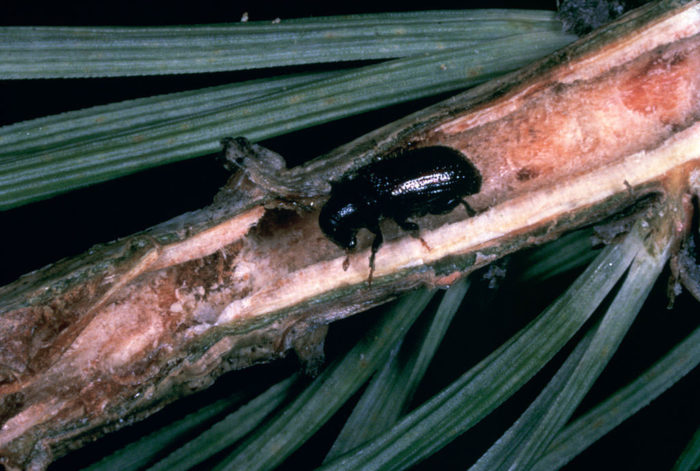
Gardeners are on the front lines when it comes to managing disease and pest issues in the landscape, so we must always be aware of potential threats in order to mitigate damage and keep our plants, gardens, and regions healthy.
Originally hailing from Europe, the pine shoot beetle (Tomicus piniperda [Linnaeus]) appears black or brown with a cylindrical shape and measures about 1/8-inch long. It was discovered in the United States at a Christmas tree farm in Ohio in 1992. Since then, these beetles have radiated outward and have been found in 20 states throughout the Midwest, Mid-Atlantic, Northeast, Southeast, and here in the Northern Plains.

As their name implies, pine shoot beetles feed on pine trees (Pinus spp. and cvs., Zones 2–10). The adult beetle attacks new growth by boring into the stem tip and moving up the shoot. By killing new shoots, the beetles stunt the overall growth of the tree. Affected shoots droop and turn yellow (also known as flagging) and eventually fall off. The beetles may also target pines by burrowing under the bark at the base of the trees and breeding in extensive galleries. This can eventually kill the tree.

Because pine shoot beetles can feed on any pine, they have the potential to cause billions of dollars in damage if they reach Western forests. Those of us in the Northern Plains are among the last line of defense to prevent this. Thankfully, we have some environmental factors to boost our resistance, namely, the northern Great Plains itself. With only pockets of native pine forests between the current quarantine zone and the Rocky Mountains, the insect has a limited chance of naturally making its way west. However, as with many invasive and introduced pests, people are the primary movers of this insect. They do so through firewood, solid wood packing material, or perhaps even through Christmas trees. The easiest way for us to keep this insect at bay is to buy locally and regionally grown firewood and trees.

Prevention methods involve cutting pine stumps in your yard low to the ground and chipping or burning any culled pines to prevent breeding sites. During the active growing season, monitor your pines for dead or bent shoots on the upper half of the tree, and clip off and open any suspected shoots to look for the beetles. If you suspect you have pine shoot beetles, contact your local extension experts or state entomologist office for confirmation and assistance with a management plan. Control is provided primarily through mechanical and chemical means in the form of sanitation, trap logs, and insecticides.
Keep your eyes open for the signs and symptoms of pine shoot beetles to prevent loss of trees for yourself and your neighbors so that we may continue to freely use and enjoy pines in our landscapes, windbreaks, and natural settings.
—Chris Schlenker is the head gardener of McCrory Gardens at South Dakota State University in Brookings, South Dakota.
Fine Gardening Recommended Products

DeWalt Variable-Speed Cordless Reciprocating Saw

DeWalt Variable-Speed Cordless Reciprocating Saw with 6-Piece Saw Blade Set


















Comments
Log in or create an account to post a comment.
Sign up Log in